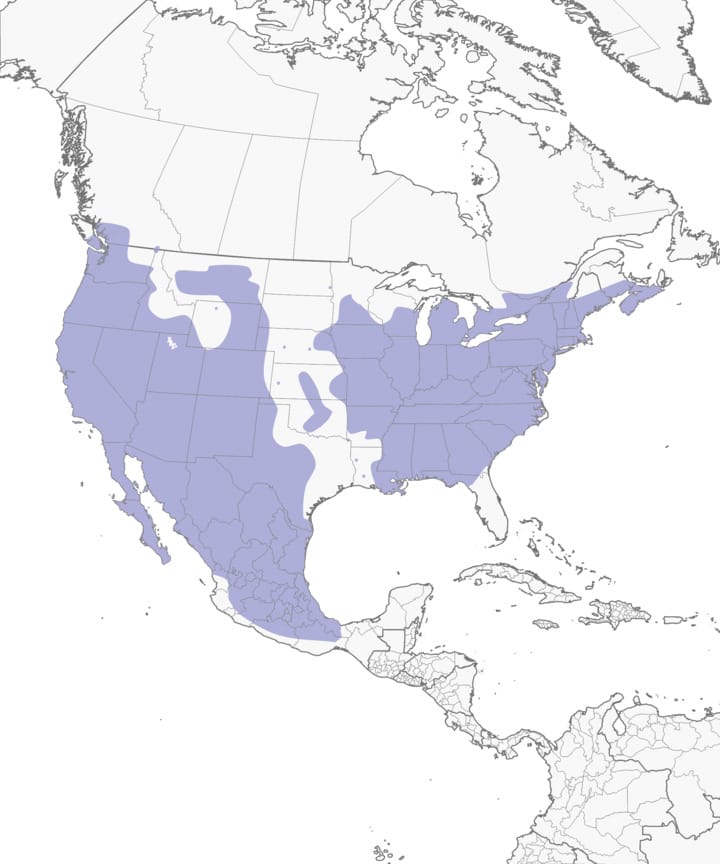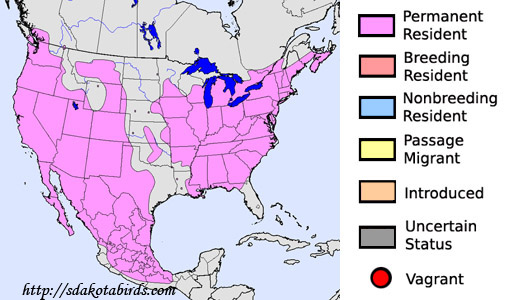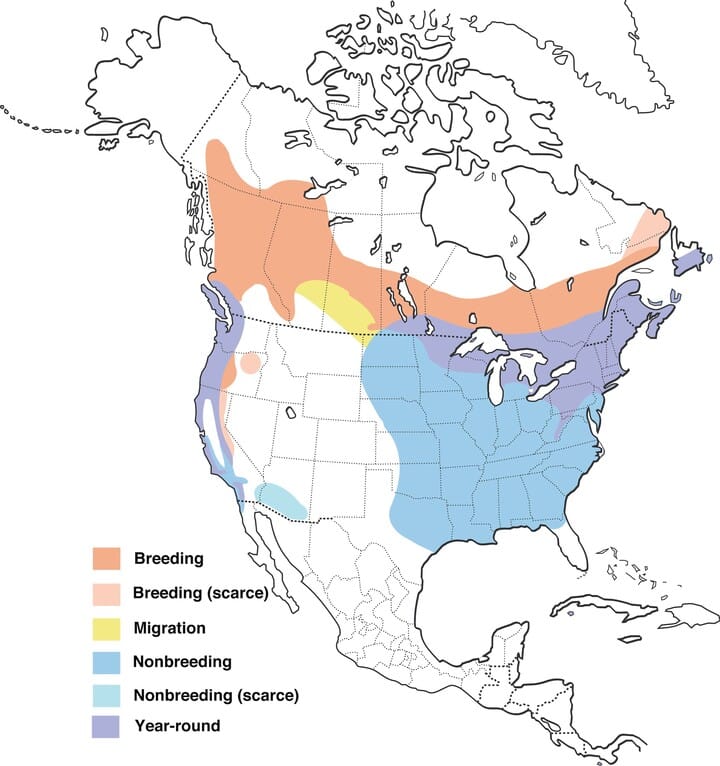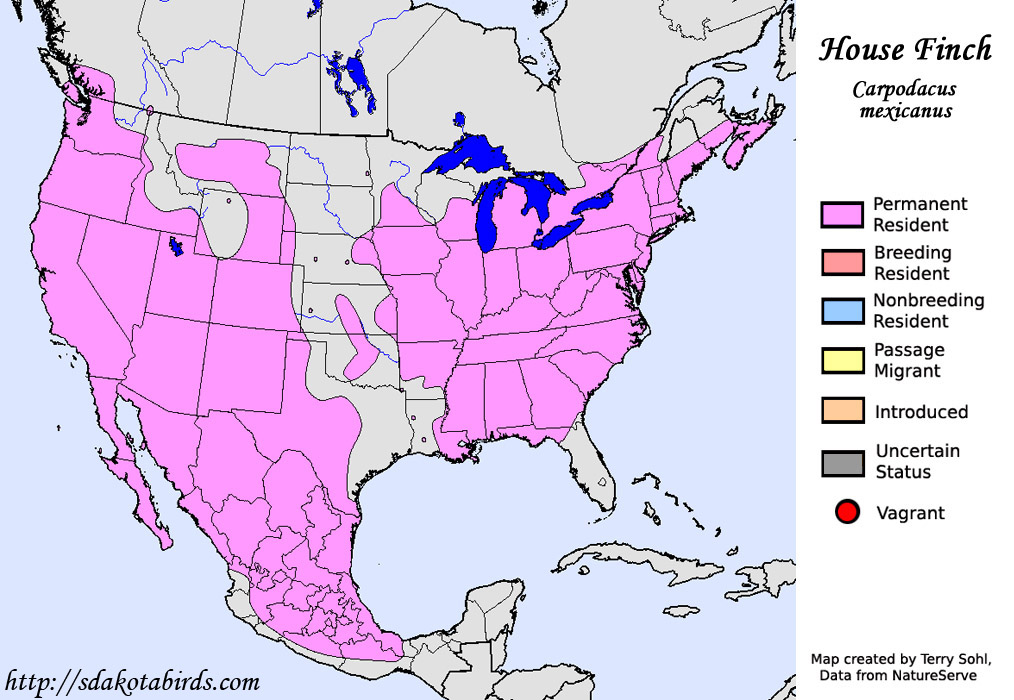House Finches are delightful little birds that have made themselves at home across a vast range of North America. From the southern border of Canada to various regions of the United States and Mexico, these feathery friends have established their presence. Interestingly, House Finches were not found in the Eastern United States 80 years ago, but they have managed to expand their territory since then. While they are more commonly found in towns and rural areas of the West, their presence is slightly less pronounced in the rural areas of the East. These charming birds have become a familiar sight, residing in the same areas year-round, although some northern House Finches may partially migrate. They have also become strongly associated with human habitation, nesting in artificial structures and thriving in urban and suburban environments. House Finches share a similar ecological niche with House Sparrows, enjoying a diet of seeds, vegetable matter, and even human food, while nesting on ledges. For bird enthusiasts looking to attract House Finches, backyard feeders with open fields, small fruit trees, and staging perches can prove to be the perfect enticement. It is worth noting that the introduction of House Finches from California to the Eastern United States in the 1940s has led to their widespread presence throughout the country.

Range
Overall range
House Finches have a wide range, living year-round in most areas of the United States and Mexico, and even extending to the southern border of Canada. They are versatile birds that have adapted well to various habitats.
Expansion in the Eastern United States
It is interesting to note that House Finches were not present in the Eastern United States 80 years ago. However, they have since expanded their range and can now be found in this region. This expansion has allowed more people in the East to observe and enjoy these beautiful birds.
Variations in different regions
The range of House Finches may vary in different regions across their habitat. While they are common in towns in the United States and rural areas of the West, they may be less common in rural areas of the East. This variation could be due to differences in the availability of suitable habitats and food sources in these regions.
Habitat
Common in towns and rural areas
House Finches are adaptable birds that can thrive in various habitats. They are commonly found in towns and rural areas across their range. Their ability to find suitable nesting sites and food sources in these environments has contributed to their widespread presence.
Resident birds
House Finches are considered resident birds, meaning they stay in the same areas year-round. They do not migrate long distances like some other bird species. This residency allows them to establish and maintain territories within their habitat, ensuring a stable population.
Partial migration in the northern part of their range
Although House Finches are generally resident birds, there is some evidence of partial migration in the northern part of their range. Some individuals in these areas may migrate shorter distances during certain times of the year, potentially in response to changes in food availability or weather conditions.
Summer Range
Variations in different regions
The summer range of House Finches may vary in different regions across their habitat. Factors such as climate, food availability, and nesting opportunities can influence their distribution during this season.
Ranges in the United States
House Finches have a widespread summer range in the United States. They can be found throughout the country, from coast to coast, and from northern states to the southern regions. Their adaptability to various climates and habitats allows them to thrive in different parts of the country.
Ranges in Canada
In Canada, House Finches also have a summer range, although it is limited to the southern border of the country. The presence of suitable habitats and food sources in these areas allows them to establish breeding territories during the summer months.
Ranges in Mexico
House Finches extend their summer range into Mexico, where they can be found in various regions. Mexico provides a favorable environment for these birds, with its diverse habitats and abundance of food sources.
Winter Range
Lack of southward movement in the eastern United States
One interesting observation about House Finches is the lack of strong evidence for a southward movement in the eastern United States during the winter season. Unlike some bird species that migrate to warmer areas during this time, House Finches seem to rely on their adaptability to survive the colder temperatures in the East.

Association with Human Habitation
Nesting in artificial structures
House Finches have developed a strong association with human habitation. They commonly nest in artificial structures such as buildings, houses, and even bird feeders. This adaptability to urban environments has helped them to thrive in areas where natural nesting sites may be limited.
Inhabiting urban and suburban habitats
Urban and suburban habitats provide House Finches with suitable food sources and nesting opportunities. These birds have learned to utilize gardens, parks, and other green spaces in these areas. They have adapted to coexist with humans and even benefit from the presence of human infrastructure.
Similar ecological niche as House Sparrows
House Finches fill a similar ecological niche as House Sparrows, another commonly found bird species in urban and suburban areas. Both species feed on seeds, vegetable matter, and human food scraps. They also nest on ledges and in crevices, making use of similar nesting sites. This similarity in ecological niche allows House Finches to thrive alongside House Sparrows in human-dominated landscapes.
Feeding Habits
Seeds and vegetable matter
House Finches primarily feed on seeds and vegetable matter. They have a diverse diet that includes various types of seeds, fruits, grains, and buds. They are particularly fond of sunflower seeds, but will also consume seeds from grasses and other plants.
Human food
House Finches have become accustomed to feeding on human food sources as well. They are not averse to visiting bird feeders or foraging for food scraps from outdoor dining areas. As long as the food is suitable for their diet, they will readily consume it.
Nesting on ledges
In addition to their diet, House Finches have a unique nesting behavior. They often choose to build their nests on ledges, both natural and artificial. This may include window ledges, tree branches, or even nest boxes. Their nesting preference makes them more visible to humans and provides opportunities for people to observe their nesting behaviors.

Attraction to Backyard Feeders
Open fields
House Finches are attracted to backyard feeders that are in proximity to open fields. These open spaces provide a suitable foraging area where they can find seeds and other food sources. The presence of feeders in such areas can greatly enhance the chances of attracting House Finches to the backyard.
Small fruit trees
Another way to attract House Finches to backyard feeders is by planting small fruit trees. House Finches are known to feed on various fruits, and having fruit-bearing trees in the yard can provide an additional food source. The combination of fruits and seeds from feeders can make the backyard an attractive feeding ground for these birds.
Staging perches
House Finches often prefer to have staging perches near their feeding areas. Staging perches are elevated structures, such as branches or poles, where birds can observe their surroundings before approaching a feeder. The presence of staging perches can make House Finches feel more secure and comfortable while feeding, increasing the likelihood of their visit to backyard feeders.
Introduction to the Eastern United States
Introduction from California in the 1940s
The introduction of House Finches from California to the Eastern United States in the 1940s marked a significant event in their range expansion. It is believed that a small population of House Finches was released in New York for captive bird trade purposes. This unintentional introduction eventually led to the establishment of a breeding population in the East.
Spread across the whole country
Since their introduction to the Eastern United States, House Finches have rapidly spread across the entire country. Their adaptability to different habitats, combined with their ability to breed and produce offspring throughout the year, has allowed them to successfully establish populations in various regions. Today, their presence is not limited to specific states or regions, but can be observed nationwide.
House Finches are remarkable birds that have demonstrated their ability to adapt and thrive in different environments. From their expansion in the Eastern United States to their association with human habitation, these birds have become a valuable part of our ecosystems. By understanding their habitat preferences, feeding habits, and attraction to backyard feeders, we can appreciate and support the presence of House Finches in our surroundings.

Leave a Reply